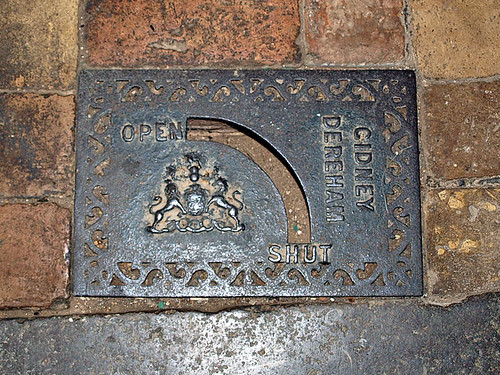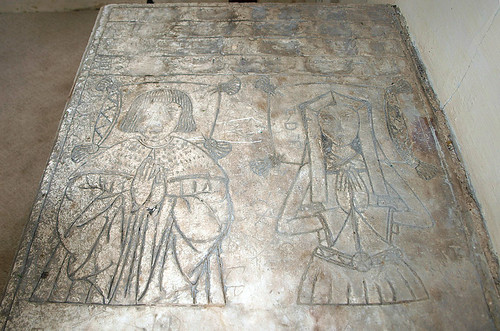ST PETER. An Anglo-Saxon round tower complete to the top, i.e. with circular windows half-way up, bell-openings of two lights with a deeply recessed shaft and arched or triangular heads three-quarters of the way up, and eight more circular openings just below the top. Narrow, but not small, arch towards the nave on the simplest imposts. The chancel has herringbone flushwork to three-quarters its length, but the windows, like those of the nave, are Perp. N porch with flushwork-panelled base and a panel with IHS above the entrance. Arcade of three bays, quatrefoiled piers with fillets and thin shafts with fillets in the diagonals. Polygonal abaci, sunk arch mouldings, i.e. later C14. Roof with embattled tie-beams and arched braces. - PULPIT. Two-sided, with Jacobean blank arches. - BENCHES. Of the Norfolk type of this area, with poppyheads and unusually many figures l. and r. Not Perp; apparently skilful work of 1857. - PLATE. Paten 1567; Chalice inscribed 1720; Paten inscribed 1804. - MONUMENT. Thomas Drake d. 1485 and wife. Tomb-chest with shields in cusped lozenge fields. Spiral-fluted angle colonnettes. On top incised slab with demi-figures.
FORNCETT ST PETER. The Tas stream flows by as the village stretches along a byway, and we come to it thinking of the Long Ago, for it has a Saxon tower, and a memory that stirs within us the thought of one of the oldest and most interesting pieces of music in the world. It has been said that it was the work of John Fornsete, but though there is no evidence for this we may be almost sure that this Norfolk monk of Reading Abbey would know its composer and would hear it sung. It is that masterpiece of medieval music Sumer is-i-cumen in, the exquisite part song which thrills us today as it must have thrilled the monks of Reading, the first known example of harmonised secular vocalised music, considered by authorities to be the most remarkable composition that has survived the centuries.
Though the idea that John of Fornsete wrote it has no foundation, John was the keeper of the charts and papers of Reading Abbey, the Chartulary, at the time the song was written, and on the margin on The Reading Calendar of those days, which is part of the manuscript in which the music is preserved, there is a prayer for John of Fornsete written apparently by the author and composer of this historic treasure. The entry is written against St Wulstan’s day, 1239, and says, Ora, Wulstane, pro nostro fratre, Johanne de Fornsete. So that Monk John brings this little place into a famous page of history.
He would know the neat little church as we see it, for it was built of flints 500 years ago, but the round tower is almost twice as old, and there is a mass dial by which the village would tell the time in the days before clocks. The tower John would know, and perhaps the dial. In the belfry are rows of tiny circular windows like peepholes, deeply splayed on both sides, and here and there are other slits for light.
The glory of the church inside is its splendid array of 54 bench ends, richly carved by medieval craftsmen, one of the finest collections we have come upon in Norfolk. Under their foliage poppyheads are figures at each side, a most interesting gallery with disciples and apostles, Judas with his money bags, a woman in what looks like a sentry box, a man with a coffer of money on his knees and a demon in front of him, another man sitting on the shoulders of a wild creature, a sower with his basket, a baker behind his counter with pies and loaves, and men with scythes. On a big 15th-century tomb are the engraved portraits of Thomas Drake and his wife Elizabeth, who founded the aisle in which they lie; he wears an ermine collar and she the kennel headdress of their day.
Both the aisles and the nave have fine old roofs. The font is 500 years old; the pulpit is a survival of the Jacobean three-decker. The rood stairs are still here and the north porch has ancient heads of a bishop and a queen.
Though the idea that John of Fornsete wrote it has no foundation, John was the keeper of the charts and papers of Reading Abbey, the Chartulary, at the time the song was written, and on the margin on The Reading Calendar of those days, which is part of the manuscript in which the music is preserved, there is a prayer for John of Fornsete written apparently by the author and composer of this historic treasure. The entry is written against St Wulstan’s day, 1239, and says, Ora, Wulstane, pro nostro fratre, Johanne de Fornsete. So that Monk John brings this little place into a famous page of history.
He would know the neat little church as we see it, for it was built of flints 500 years ago, but the round tower is almost twice as old, and there is a mass dial by which the village would tell the time in the days before clocks. The tower John would know, and perhaps the dial. In the belfry are rows of tiny circular windows like peepholes, deeply splayed on both sides, and here and there are other slits for light.
The glory of the church inside is its splendid array of 54 bench ends, richly carved by medieval craftsmen, one of the finest collections we have come upon in Norfolk. Under their foliage poppyheads are figures at each side, a most interesting gallery with disciples and apostles, Judas with his money bags, a woman in what looks like a sentry box, a man with a coffer of money on his knees and a demon in front of him, another man sitting on the shoulders of a wild creature, a sower with his basket, a baker behind his counter with pies and loaves, and men with scythes. On a big 15th-century tomb are the engraved portraits of Thomas Drake and his wife Elizabeth, who founded the aisle in which they lie; he wears an ermine collar and she the kennel headdress of their day.
Both the aisles and the nave have fine old roofs. The font is 500 years old; the pulpit is a survival of the Jacobean three-decker. The rood stairs are still here and the north porch has ancient heads of a bishop and a queen.




No comments:
Post a Comment